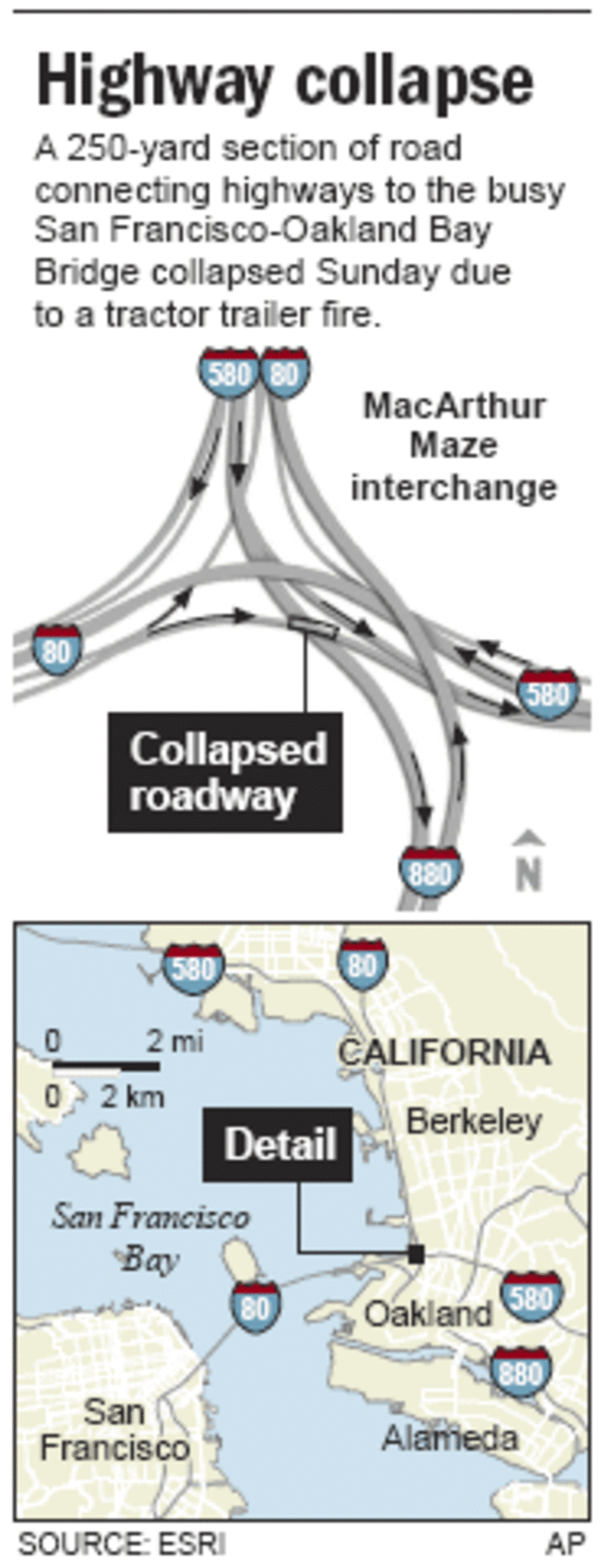Free public transportation eased traffic immediately after a fiery wreck destroyed part of a major Bay area highway, but Tuesday’s return of regular-priced transit will be the real test for what lies ahead during the long repairs.
Tuesday morning rush-hour traffic moved slowly, but gridlock didn’t materialize. Transportation officials anticipate more severe delays in the afternoon when East Bay commuters returning home from San Francisco are forced to detour to avoid the collapsed overpass.
Officials hoped the motorists would continue to ride ferries, buses and the Bay Area Rapid Transit rail system while the vital link between San Francisco and its eastern suburbs remained closed.
City officials have called for a review of the rules that allowed a driver with a criminal background to haul the 8,000 gallons of gasoline that burned and weakened the overpass early Sunday, causing it to crumple onto another below.
The downed overpass and the connector ramp onto which it collapsed carried some 80,000 vehicles a day through interchanges that funneled traffic from the Bay Bridge to a number of key freeways. Inspectors X-rayed about a dozen pillars supporting the ramp near the collapsed section to see if they could be salvaged.
Originally built in the 1950s, the collapsed roadway was retrofitted to withstand earthquake damage in the late 1990s. But rather than rebuild the ramp according to already existing blueprints, engineers will likely overhaul the interchange to conform to today’s more stringent seismic standards, California Department of Transportation spokesman Jeff Weiss said.
“Whenever you can start from scratch, you do so,” Weiss said.
Best-case scenario
The experts paid to worry about disasters and terrorism have for years warned of collapsing highway bridges and exploding tanker trucks. They just never foresaw one event that would encompass both.
Some officials said Sunday’s wreck produced a best-case outcome.
“It’s almost your perfect tabletop exercise — real pristine, clean, and nobody got hurt,” California Highway Patrol Officer Mike Wright said.
While crews sifted through the wreckage, outside experts did their own analysis. In one line of inquiry that could improve future responses, some scientists were studying linkages between the freeway collapse and how the World Trade Center came down on Sept. 11, 2001.
The structural failures appear similar, said David McCallen, division leader in nonproliferation, homeland and international security at the Lawrence Livermore National Laboratory.
The steel supporting the overpass turned pliable after the gasoline-fed fire below reached temperatures up to 2,000 degrees — more than four times as hot as the hottest conventional home oven.
The big difference between a blast and a fire is the fire takes time, “which gives you the potential or the option of responding,” McCallen said. In this case, it makes sense to look at better ways to douse fuel-based fires, McCallen said.
Crews finished hauling away charred debris Monday night and engineers prepared for reconstruction, which could take two to three months.
Concerns raised about background checks
With the wreckage from the upper ramp cleared, inspectors Tuesday morning began taking samples of concrete, asphalt and steel to determine how badly the lower roadway had been damaged, California Department of Transportation spokesman Bob Haus said.

The incident and its aftermath also raised new questions about those behind the wheel of big trucks.
While the government screens the thousands of truck drivers who haul hazardous materials around the country — most recently requiring that they undergo FBI and intelligence background checks — it was unclear whether the system worked in the case of tanker driver James Mosqueda.
Court records show that Mosqueda had a criminal record that included convictions for heroin possession and burglary. Yet apparently all the paperwork for him to get his trucking license was in order, the California Highway Patrol said.
An initial investigation revealed that the truck may have been speeding, but drugs and alcohol were not suspected as factors in the crash, CHP Officer Trent Cross said.
Mosqueda had recently renewed his commercial driver’s license and his driving record was free of any crashes or violations before Sunday, according to the California Department of Motor Vehicles.
After the crash, Mosqueda, 51, wandered more than a mile through darkened streets in Oakland with second-degree burns to a gas station and hailed a cab to take him to the emergency room, according to police and the taxi driver.
Mosqueda had been a driver for his current employer, Sabek Transportation, for about 10 months when the crash occurred, said CHP Officer Trent Cross.
Several calls to Sabek by The Associated Press were either hung up on or forwarded to a voicemail box for Tom Saberi, who has previously been listed as an attorney for the company. Saberi did not return any messages.
